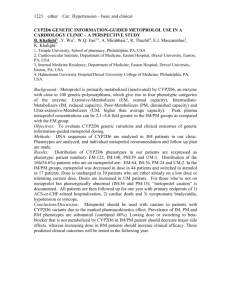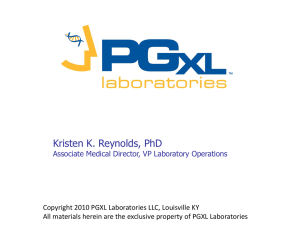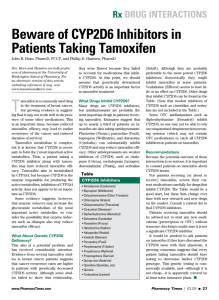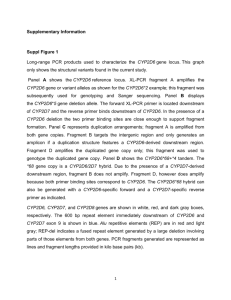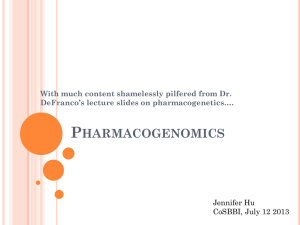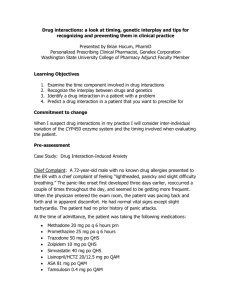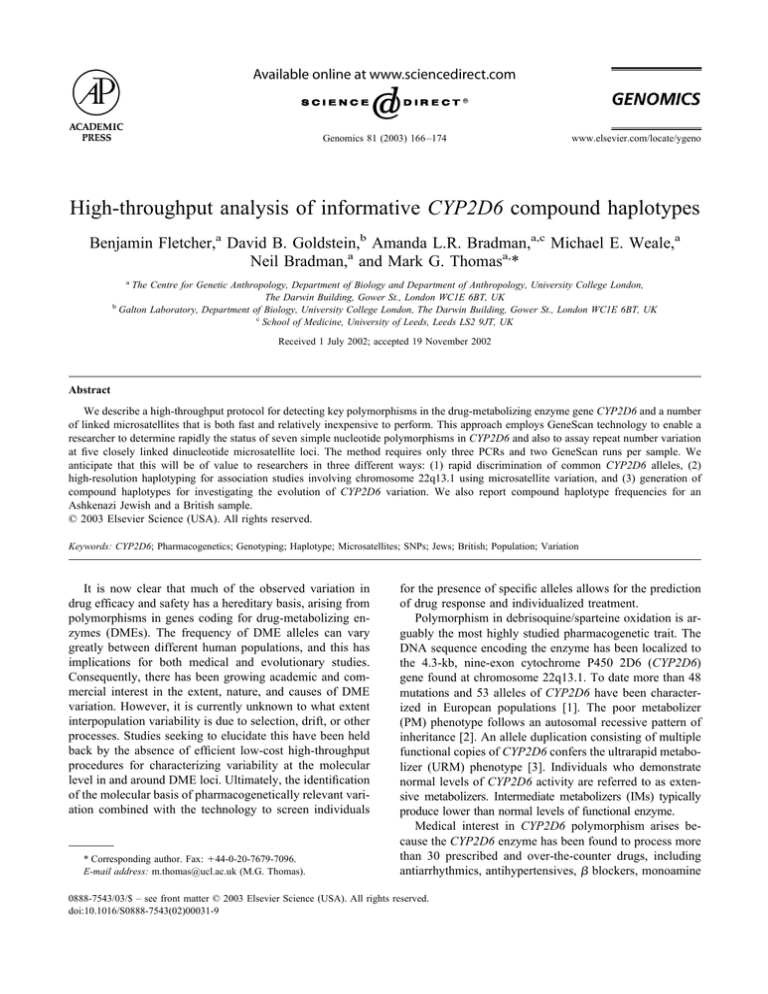
Available online at www.sciencedirect.com
R
Genomics 81 (2003) 166 –174
www.elsevier.com/locate/ygeno
High-throughput analysis of informative CYP2D6 compound haplotypes
Benjamin Fletcher,a David B. Goldstein,b Amanda L.R. Bradman,a,c Michael E. Weale,a
Neil Bradman,a and Mark G. Thomasa,*
a
The Centre for Genetic Anthropology, Department of Biology and Department of Anthropology, University College London,
The Darwin Building, Gower St., London WC1E 6BT, UK
b
Galton Laboratory, Department of Biology, University College London, The Darwin Building, Gower St., London WC1E 6BT, UK
c
School of Medicine, University of Leeds, Leeds LS2 9JT, UK
Received 1 July 2002; accepted 19 November 2002
Abstract
We describe a high-throughput protocol for detecting key polymorphisms in the drug-metabolizing enzyme gene CYP2D6 and a number
of linked microsatellites that is both fast and relatively inexpensive to perform. This approach employs GeneScan technology to enable a
researcher to determine rapidly the status of seven simple nucleotide polymorphisms in CYP2D6 and also to assay repeat number variation
at five closely linked dinucleotide microsatellite loci. The method requires only three PCRs and two GeneScan runs per sample. We
anticipate that this will be of value to researchers in three different ways: (1) rapid discrimination of common CYP2D6 alleles, (2)
high-resolution haplotyping for association studies involving chromosome 22q13.1 using microsatellite variation, and (3) generation of
compound haplotypes for investigating the evolution of CYP2D6 variation. We also report compound haplotype frequencies for an
Ashkenazi Jewish and a British sample.
© 2003 Elsevier Science (USA). All rights reserved.
Keywords: CYP2D6; Pharmacogenetics; Genotyping; Haplotype; Microsatellites; SNPs; Jews; British; Population; Variation
It is now clear that much of the observed variation in
drug efficacy and safety has a hereditary basis, arising from
polymorphisms in genes coding for drug-metabolizing enzymes (DMEs). The frequency of DME alleles can vary
greatly between different human populations, and this has
implications for both medical and evolutionary studies.
Consequently, there has been growing academic and commercial interest in the extent, nature, and causes of DME
variation. However, it is currently unknown to what extent
interpopulation variability is due to selection, drift, or other
processes. Studies seeking to elucidate this have been held
back by the absence of efficient low-cost high-throughput
procedures for characterizing variability at the molecular
level in and around DME loci. Ultimately, the identification
of the molecular basis of pharmacogenetically relevant variation combined with the technology to screen individuals
* Corresponding author. Fax: ⫹44-0-20-7679-7096.
E-mail address: m.thomas@ucl.ac.uk (M.G. Thomas).
for the presence of specific alleles allows for the prediction
of drug response and individualized treatment.
Polymorphism in debrisoquine/sparteine oxidation is arguably the most highly studied pharmacogenetic trait. The
DNA sequence encoding the enzyme has been localized to
the 4.3-kb, nine-exon cytochrome P450 2D6 (CYP2D6)
gene found at chromosome 22q13.1. To date more than 48
mutations and 53 alleles of CYP2D6 have been characterized in European populations [1]. The poor metabolizer
(PM) phenotype follows an autosomal recessive pattern of
inheritance [2]. An allele duplication consisting of multiple
functional copies of CYP2D6 confers the ultrarapid metabolizer (URM) phenotype [3]. Individuals who demonstrate
normal levels of CYP2D6 activity are referred to as extensive metabolizers. Intermediate metabolizers (IMs) typically
produce lower than normal levels of functional enzyme.
Medical interest in CYP2D6 polymorphism arises because the CYP2D6 enzyme has been found to process more
than 30 prescribed and over-the-counter drugs, including
antiarrhythmics, antihypertensives,  blockers, monoamine
0888-7543/03/$ – see front matter © 2003 Elsevier Science (USA). All rights reserved.
doi:10.1016/S0888-7543(02)00031-9
B. Fletcher et al. / Genomics 81 (2003) 166 –174
oxidase inhibitors, morphine derivatives, antipsychotics,
and tricyclic antidepressants [4]. The extreme variation in
the activity of CYP2D6 caused by these polymorphisms can
produce an undesired response to drug therapies in a number of ways. In the case of individuals with the PM phenotype, prodrugs may not be converted to the active form in
sufficient quantity to be therapeutic, e.g., absence of the
analgesic effect of codeine when it is not converted to
morphine [5]. Alternatively, failure to clear a drug may lead
to its accumulation and induce an adverse drug reaction
(hyperresponse). When individuals with the URM phenotype are administered normal clinical doses of drugs, they
clear them too quickly. In the latter case, the drug is either
absent from blood serum or present at subtherapeutic quantities with the consequence that subjects require correspondingly higher doses of drugs to receive therapeutic benefit,
e.g., therapeutic failure of normal antidepressant doses [6].
In the case of the IM phenotype, status has been hypothesized to be potentially important for drugs with narrow
therapeutic windows. Several studies have suggested that
variation in CYP2D6 can affect neurological disease susceptibility [7] as well as being a potential modulator of
cancer risk [8]. Evolutionary interest in CYP2D6 arises
because of the primary role that DMEs have in the metabolism of dietary toxins such as alkaloids [9].
Microsatellites are short tandemly repeated nucleotide
motifs of two to five bases that are found throughout the
genomes of eukaryotes, e.g., (CA)n. Many of these loci have
been found to be highly polymorphic, with variation occurring in the number of repeat units in different alleles [10].
Consequently, microsatellites are useful in many types of
modern genetic study, including forensics [11], phylogenetic reconstruction [12], dating mutational events [13],
demographic history [14], linkage analysis [15], testing for
selection [16], mapping complex genetic diseases [17], and
identifying quantitative trait loci [18]. More recently, compound haplotypes made up of combinations of microsatellites and “simple nucleotide polymorphisms” (SNPs) have
been used extensively to differentiate populations [19],
study human migration in prehistory [20], date events in
prehistory [21], and estimate the age of mutations [22]. We
use the definition of SNPs as simple nucleotide polymorphisms, in preference to the more commonly used “single
nucleotide polymorphisms,” as it is inclusive of indel mutations. The study of compound haplotypes is likely to
assume increasing importance given that recent studies suggest that linkage disequilibrium is highly structured into
discrete “blocks” separated by recombination hot spots [23].
The construction of multiplex PCR systems has been
widely used to increase the throughput and decrease the cost
of typing large numbers of SNPs and microsatellite loci
[24]. Here we describe a method for typing seven previously
reported SNPs in CYP2D6 and five closely linked microsatellite loci. Selection of polymorphisms for inclusion in
the CYP2D6 SNP protocol was based on: (1) identification
of key mutations that result in altered CYP2D6 activity and
167
(2) mutual compatibility of markers within the multiplex
system. The SNP protocol was designed to ensure that five
distinct loci could be amplified by multiplex PCR, digested
with a cocktail of restriction enzymes, and then typed by the
presence or absence of DNA fragments of specific size and
dye label on an ABI-377 automated sequencer or equivalent
for GeneScan analysis. GeneScan is an integrated genotyping technology platform developed by Applied Biosystems
(http://home.appliedbiosystems.com/) consisting of an electrophoretic gel tank (either slab or capillary based) combined with a laser detection system and analysis and laboratory information management software. Several primers
were modified to incorporate mismatches at a single position to create a restriction enzyme recognition site when the
naturally occurring polymorphism alone did not result in the
presence/absence of a restriction site.
The SNPs detected are numbered as indicated in the
standardized CYP2D6 nomenclature (http://www.imm.
ki.se/CYPalleles/CYP2D6.htm): C100T (Pro34Ser), C1023T
(Thr107Ile), G1846A (splicing defect), 1863 ⫹9-bp repeat
(172-174FRP rep), A2549del (frameshift), 2613-2615AGAdel
(Lys281del), and C2850T (Arg296Cys). These polymorphisms can be used to distinguish between CYP2D6*2
[3], CYP2D6*3 [25], CYP2D6*4 [26], CYP2D6*9 [27],
CYP2D6*10 [28], CYP2D6*17 [29], and CYP2D6*30 [1].
CYP2D6*3 and *4 alleles either fail to produce enzymes or
produce defective ones with no activity. CYP2D6*9, *10,
and *17 produce enzymes with reduced activity relative to
the wild type, CYP2D6*1. The CYP2D6*2 allele, and to a
lesser extent the CYP2D6*1 and CYP2D6*4 alleles, are
sometimes duplicated. In the cases of CYP2D6*2 and
CYP2D6*1, allele duplication confers the URM phenotype.
The phenotypic effect of CYP2D6*30 has not yet been fully
characterized.
The five previously reported dinucleotide microsatellites,
D22S276, D22S279, D22S284, D22S423, and CYP2D8P,
are all less than 1 cM from the CYP2D gene cluster and
have been used in association studies to explore the role of
CYP2D6 in neurological disease [30]. The typing of these
markers in families should be useful in creating high-resolution haplotypes for linkage disequilibrium mapping studies to explore variation in CYP2D6 or other genes localized
to 22q13.1. This approach has already been successfully
employed for numerous genetic disorders including Batten
disease [31], Huntington’s disease [32], and cystic fibrosis
[33]. Furthermore, the CYP2D6*4 allele has already been
shown to be associated with long-type (repeat length ⱖ22)
CYP2D8P alleles [34].
The multiplex PCR protocols required considerable optimization. Primers for all loci had to be designed to ensure
that all products fell within a limited size range (75– 400 bp)
that was suitable for GeneScan analysis and that the different amplicons and their associated restriction enzyme digestion products could be discriminated using a combination of fragment size and fluorescent ABI dye label (HEX,
TET, and FAM). The method requires only three PCRs and
168
B. Fletcher et al. / Genomics 81 (2003) 166 –174
Table 1
SNP protocol: expected and observed product sizes after multiplex enzyme digestion
Polymorphism
in CYP2D6
Allele(s)
100 C3T
1023 C3T
1846 G3A
2549 A3del
2850 C3T
*4, *10
*17
*4
*3
*2, *17
a
Discriminating
enzyme
Cut size (bp)
Uncut size (bp)
Expected
Observed
Expected
Observed
NheI
XbaI
AvrII
TatI
FspI
79 (C)
89 (T)
292 (G)
221 (A)
79 (C)
79.5
92.0
291.5
221.5
78.5
94 (T)
108 (C)
307 (A)
243 (del)
211 (T)
94.5
110.0
306.5
243.5
211.5
a
a
Dye
label
TET
HEX
FAM
HEX
FAM
Using ABI-377/TAMRA-350.
two runs per sample on an ABI-377 automated sequencer or
equivalent. The resulting amplicons in these multiplex protocols are analyzed in the presence of GS-350 or GS-500
molecular size standards labeled with the fluorescent dye
TAMRA (PE–Applied Biosystems). Due to the high degree
of sequence similarity between CYP2D6 and its two related
pseudogenes, CYP2D7 and CYP2D8P, a specific preamplification PCR is required to provide a CYP2D6-only template for subsequent amplification reactions. We also report
frequencies of compound haplotypes, consisting of all the
markers described above, for an Ashkenazi Jewish and a
British sample.
Results and discussion
Both protocols have been employed successfully to amplify DNA from samples taken as blood or buccal swabs
and extracted with standard phenol/chloroform procedures,
silica/guanidinium thiocyanate methods, and commercial
kits (Qiagen, Inc., Valencia, CA, USA). To date we have
determined over 2500 compound genotypes and haplotypes
comprising all 12 polymorphic markers. The SNP protocol
was recently used to assay CYP2D6 variation as part of a
study into how human population genetic structure affects
the evaluation of drug safety, efficacy, and response [35].
The protocols were designed to ensure, as far as possible,
similar signal intensities following GeneScan analysis of all
observed products. Protocol performance was optimized by
the following: (1) careful primer design and the modification of previously published primer sequences so that all
primer pairs within a multiplex amplify at a similar optimal
annealing temperature, (2) varying primer concentrations
and using the lowest concentration that would give peak
heights of around 2000 units in GeneScan analysis, (3)
varying PCR annealing temperatures and using the highest
temperature that would allow reliable amplification of all
regions, and (4) using the lowest MgCl2 concentration permissible for amplification of all regions. In our experience,
the use of TaqStart MAb increases the specificity of the
PCR. As specificity is an important factor in optimizing
multiplex amplification, we used this reagent in all reactions. Some variation was observed in intensity of signal
peaks between different DNA samples. However, absence
of clear peaks for one or more loci was observed only in
samples containing DNA that was either severely degraded
or present at very low concentrations. Prudent design and
dye labeling of the primers to detect the 1846 G 3 A
(CYP2D6*4) and 2549 A 3 del (CYP2D6*3) mutations
combined with the superior resolution of GeneScan analysis
also allowed for the detection of two further indel mutations
in their amplicons: the 1855–1863 ⫹9-bp insertion
(CYP2D6*30) and the 2615 3-bp deletion (CYP2D6*9).
Subjects with these mutations produce digestion products
with sizes slightly different from those observed in wild
type: a 301-bp rather than 292-bp FAM-labeled product for
CYP2D6*30 and a 218-bp rather than 221-bp HEX-labeled
product for CYP2D6*9.
The sizing of DNA fragments using GeneScan technology is not absolute [24]. The actual observed product sizes
assigned to PCR products using GeneScan analysis software, although consistent across runs, can differ from the
predicted product size by up to 6 nucleotides. Therefore,
accurate scoring of SNPs and microsatellite repeat lengths
using the protocols required calibration against DNA samples of known microsatellite repeat number and CYP2D6
genotype. Observed product sizes for the SNPs were generally in good agreement with the predicted sizes (within
⫾0.5 bp), the exception being the 1023 C 3 T-containing
product used to detect CYP2D6*17 appearing 2 bp larger
than expected (Tables 1 and 2). Observed microsatellite
repeat lengths for the CEPH (http://www.cephb.fr/) sample
1347-02 are provided in Table 3 as a standard. Comparable
results should be attainable using other slab gel- or capillary-based systems. DNA standards are also available from
the authors.
Sample data generated by the protocols to produce compound haplotypes are presented in Table 4. Data were ob-
Table 2
SNP protocol: additional indels detected
Polymorphism
in CYP2D6
Allele
1855–1863 ⫹9-bp insertion
2615 AGA deletion
*30
*9
a
Using ABI-377/TAMRA-350.
Size (bp)
Expected
Observeda
301
218
300.5
218.5
Dye
label
FAM
HEX
B. Fletcher et al. / Genomics 81 (2003) 166 –174
Table 3
Microsatellite protocol: observed microsatellite repeat scores for CEPH
standard sample 1347-02
Locus
Repeat length of allele
D22S276
D22S279
D22S284
D22S423
CYP2D
220–226
124–126
116–116
252–252
340–342
tained from Ashkenazi Jewish and British families consisting of both parents and one or more offspring, but only data
on the unrelated parents are shown. Phase of parental haplotypes was assigned from their offspring’s genotype data
according to the method outlined in [36]. The Ashkenazi
Jewish data on unrelated parents were used to test for
linkage disequilibrium between each microsatellite locus
and the alleles detected at the CYP2D6 locus, using the
exact test described in [37]. The results were D22S279 (p ⫽
0.080), D22S423 (p ⫽ 0.101), D22S284 (p ⫽ 0.210),
CYP2D8P (p ⬍ 0.0001), and D22S276 (p ⫽ 0.0002). We
note that the order of increasing p values matches the order
of loci according to the June 2002 Freeze of the human
genome physical map (midpoints relative to the first base of
CYP2D6: D22S279 ⫽ ⫺1.50 Mb, D22S423 ⫽ ⫺2.14 Mb,
D22S284 ⫽ ⫺2.21 Mb, CYP2D8P ⫽ 14.7 kb, D22S276 ⫽
⫺0.51 Mb), but not the order of loci according to the
genetic map presented in [32] (relative to CYP2D6:
D22S279 ⫽ ⫺0.9 cM, D22S423 ⫽ ⫺0.6 cM, D22S284 ⫽
⫺0.3 cM, CYP2D8P ⫽ ⫺0.0 cM, D22S276 ⫽ ⫹0.4 cM).
When we compared the Ashkenazi Jewish and British unrelated parents using only CYP2D6 allele frequencies, we
found no significant difference between the two samples
(using the exact test of [37], p ⫽ 0.493). However, when we
added the haplotype information from the five microsatellite
loci, we were able to distinguish the two samples (p ⫽
0.047), illustrating the greater resolving power available
with the compound haplotypes.
We compared our data with previously published data on
CYP2D6 allele frequencies in Western Europeans (n ⫽
3292) [38] and Saudi Arabians (n ⫽ 202) [9]. Our British
sample did not differ significantly from the Western European sample (p ⫽ 0.487 using exact test), despite the very
high Western European sample size. CYP2D6*4, the primary cause of PM phenotype, was found at a frequency of
15.9% in the Ashkenazi. This is slightly below the levels
found in the British (19.8%) and the Western Europeans
(20.0%) but considerably in excess of levels in Saudi Arabians (3.0%). This difference is reflected in a lower FST
value between Ashkenazi and British (FST ⫽ ⫺0.005) and
between Ashkenazi and Western Europeans (FST ⫽ 0.002)
than between Ashkenazi and Saudi Arabians (FST ⫽ 0.042).
The greater similarity of Ashkenazi Jews to Western Europeans (including the British) may be due to inward gene
169
flow into the Ashkenazi Jewish community from surrounding populations [38].
The protocol described here has advantages over previous typing methods in (1) being more cost effective, being
less labor intensive, and producing a higher throughput than
simplex PCR/RFLP methods; (2) amplifying from lowyield DNA sources such as buccal swab samples as well as
high-yield DNA sources such as blood and tissue; (3) requiring less investment of time and financial resources than
other high-throughput typing technologies such as GeneChip CYP450 Assay Arrays (Affymetix, Inc., Santa Clara,
CA, USA); and (4) that there are no licensing issues.
We anticipate several uses for these protocols. On its
own the CYP2D6 SNP protocol enables a researcher to
quickly and cheaply characterize individuals for the most
common CYP2D6 alleles. When combined with previously
published methods to detect CYP2D6*5 alleles (that are not
compatible with multiplexing), this approach can identify
⬃90% of individuals in Western European populations with
PM phenotype [39]. CYP2D6*4 is also found at relatively
high frequencies in several non-European populations:
8.3% in Canadian Inuit [40], 8.5% in African Americans
[41], and 11.3% in Turks [42]. Due to the low incidence of
defective alleles in Africans and Oriental Asians, PM phenotypes are rare in these populations compared with Western Europeans [43]. However, the remaining two alleles that
are detected by the protocol and confer reduced levels of
metabolism are common in African and Oriental Asian
populations. In published datasets for Asian populations
CYP2D6*10 ranges from 40% in Japanese [44] to 70% in
Taiwanese Chinese [45]; CYP2D6*17 ranges in published
datasets for African populations from 9% in Ethiopians [46]
to 34% in Zimbabweans [47]. The genotypic information
that the protocol provides can be used in conjunction with
known CYP2D6 allele frequencies in different ethnic groups
as a guide to deciding which other polymorphisms should
be characterized, depending on whether a study is concerned with identifying URM or IM phenotypes. For example, CYP2D6*2 alleles can be further characterized into
three distinct haplotypes that confer different enzyme activities: the multiduplicated CYP2D6*2(n) [3], CYP2D6*2
[⫺1496G], and CYP2D6*2 [⫺1496C] [48]. The multiduplicated CYP2D6*2 and variants cause the overexpression
of CYP2D6 enzyme that results in the URM phenotype:
CYP2D6*2 [⫺1496G] has several amino acid differences
from the wild type (CYP2D6*1), but comparable enzyme
activity; the variant with the 5⬘ flanking sequence ⫺1496C
mutation in the presumed transcription initiation site causes
the gene to be transcribed less efficiently and the
CYP2D6*2 [⫺1496C]/*0 (null) genotype is believed to be
responsible for at least 50 – 60% of IM phenotypes in Europeans.
In stand-alone use the CYP2D6 microsatellite protocol
provides a cost-effective way of providing high-resolution
haplotypes for association studies of the 22q13.1 region.
Genes that have been found to be within a few centimorgans
170
B. Fletcher et al. / Genomics 81 (2003) 166 –174
Table 4
Compound haplotypes in Ashkenazi Jewish and British samples
CYP2D6 allele
Microsatellite haplotypea
Ashkenazi
CYP2D6*1
15
17
17
17
17
17
17
17
17
17
17
17
17
17
17
17
17
17
17
17
17
17
17
17
17
17
17
17
17
17
17
17
17
18
18
18
18
18
18
18
18
18
18
18
18
18
18
18
18
18
18
19
19
19
19
19
19
19
19
19
19
19
1
1
25
19
19
19
19
19
20
20
20
20
20
20
20
21
21
21
22
22
23
23
23
23
24
24
25
25
25
25
25
25
26
26
29
19
19
19
19
19
20
20
20
20
20
20
21
21
23
24
25
25
28
19
19
19
19
19
19
20
20
20
20
20
22
18
22
23
25
25
18
19
22
23
23
24
25
17
26
26
20
20
19
22
23
23
22
23
23
23
23
23
23
23
18
23
23
18
23
23
23
24
18
20
23
23
23
25
21
23
26
22
21
24
20
18
18
22
22
22
23
18
23
23
23
24
27
19
21
19
19
26
19
19
19
19
20
19
19
27
19
21
19
19
24
20
19
20
19
19
19
19
19
20
20
25
19
20
19
21
19
19
27
27
19
20
19
19
20
19
19
19
27
19
19
19
19
19
19
19
19
20
19
25
19
19
20
19
18
17
17
17
21
17
18
17
17
21
18
21
21
18
18
22
17
22
18
17
17
21
17
17
17
18
21
18
21
17
18
21
17
22
16
21
18
18
17
18
17
21
21
17
21
21
21
18
21
17
22
17
18
17
21
18
18
17
17
21
21
18
British
—
—
—
1
1
—
—
1
1
1
1
—
1
—
—
1
1
1
—
—
—
—
—
1
1
1
1
1
1
—
—
—
—
—
1
1
1
1
2
1
—
—
—
—
—
1
1
2
1
1
CYP2D6*2
—
—
—
—
1
1
1
—
—
1
1
1
—
—
—
1
1
1
1
—
—
—
—
2
1
1
—
—
—
1
1
2
—
—
—
1
1
1
—
—
—
—
—
1
1
1
—
—
—
—
—
1
1
1
1
1
1
1
1
1
2
1
1
1
CYP2D6 allele
—
—
1
—
—
—
—
—
Microsatellite haplotypea
Ashkenazi
19
19
19
19
19
19
19
19
19
19
19
19
20
20
20
20
20
20
20
20
21
21
21
21
15
17
17
17
17
17
17
17
17
17
17
17
17
17
17
17
17
17
17
17
17
17
17
18
18
18
18
18
18
18
18
18
18
18
18
19
19
19
1
21
23
24
25
25
25
25
25
25
25
26
26
17
17
19
20
21
25
25
25
17
17
23
26
25
17
18
18
18
19
19
19
19
19
19
19
20
20
20
21
21
21
21
24
25
25
29
16
19
19
19
19
20
20
20
21
21
25
25
17
18
18
21
24
21
18
22
23
23
23
23
23
23
25
18
18
24
18
21
23
23
28
23
23
18
25
23
23
23
24
24
18
18
22
23
23
23
25
20
21
25
17
22
23
26
28
22
23
23
22
19
19
23
23
22
23
23
20
23
20
23
18
18
23
26
19
19
19
19
19
19
20
25
28
19
19
19
19
19
19
19
19
19
19
19
19
19
21
20
28
20
20
24
19
20
20
19
20
20
20
21
20
19
27
20
20
21
22
19
18
19
20
19
20
20
20
21
20
21
19
21
20
26
21
27
20
17
17
17
18
17
17
18
18
17
18
18
17
18
21
17
17
17
17
21
22
17
21
21
20
20
18
21
17
17
17
17
18
17
17
21
18
22
18
16
18
17
17
22
17
17
24
17
19
16
18
16
21
17
21
19
18
19
17
20
21
17
17
British
—
—
1
1
1
2
1
2
1
1
—
—
1
1
2
—
—
—
1
1
1
—
—
—
1
—
—
—
1
1
1
1
1
1
1
—
1
1
—
1
1
1
4
—
—
—
—
—
—
2
1
2
1
1
1
1
1
—
—
—
—
1
1
2
2
—
—
—
—
—
1
1
1
—
—
1
1
—
1
3
—
1
—
2
1
1
1
1
—
—
—
—
—
—
—
—
—
1
1
1
1
1
1
1
—
—
—
—
—
—
—
1
1
1
1
1
3
—
—
—
—
1
1
(continued on next page)
B. Fletcher et al. / Genomics 81 (2003) 166 –174
171
Table 4 (continued)
CYP2D6 allele
CYP2D6*3
CYP2D6*4
Microsatellite haplotypea
19
19
19
19
19
19
19
19
19
19
19
19
19
19
19
19
19
20
20
20
20
20
20
20
21
21
21
19
19
17
17
17
17
17
17
19
19
20
20
20
20
21
24
24
24
25
25
25
25
25
26
26
19
21
23
23
24
24
25
17
19
26
25
27
17
19
20
20
20
20
18
19
23
23
23
23
21
23
23
24
23
23
23
23
23
23
23
25
21
23
25
21
24
18
23
18
25
23
25
20
20
18
22
23
23
19
20
19
20
21
23
20
20
20
20
19
20
20
20
24
19
20
20
19
20
19
20
20
20
19
20
21
19
19
20
27
27
20
25
27
17
19
16
18
17
17
17
21
25
21
17
17
18
21
17
17
21
17
17
21
17
18
16
18
21
21
20
21
17
18
18
18
21
18
17
Ashkenazi
—
British
CYP2D6 allele
1
1
1
—
—
—
1
1
1
—
—
—
1
1
1
1
—
—
—
—
—
1
2
1
1
1
1
1
—
1
—
—
—
—
—
—
—
—
—
—
1
1
1
1
1
1
1
1
1
1
—
—
—
—
—
—
1
1
1
1
CYP2D6*5b
—
—
—
—
—
1
1
1
1
CYP2D6*9
CYP2D6*17
Total
Microsatellite haplotypea
Ashkenazi
17
17
17
17
17
17
17
18
18
18
18
18
18
18
18
18
18
18
18
18
18
19
19
19
19
19
19
21
17
18
18
19
17
17
1
20
20
21
22
24
25
28
19
19
19
19
19
20
20
20
20
20
20
24
25
25
17
19
20
20
23
25
26
25
16
19
26
22
23
24
25
17
20
23
22
20
22
23
23
24
24
18
21
22
22
22
23
23
20
22
18
23
19
23
23
23
25
23
22
23
23
19
21
26
27
27
26
27
27
26
27
21
27
27
28
27
27
19
27
27
27
27
26
27
27
27
23
27
26
25
27
27
19
27
19
24
24
19
18
18
18
18
18
18
18
18
18
18
18
18
18
18
17
18
18
18
17
18
18
18
17
17
18
17
18
18
18
18
17
18
18
British
—
—
—
—
—
1
1
1
1
—
—
1
1
2
—
1
3
—
—
—
—
1
1
1
1
2
2
1
—
—
—
—
—
—
—
—
—
1
2
1
1
1
1
1
1
1
1
1
1
1
—
—
—
—
—
—
—
—
1
—
1
1
1
1
126
—
—
—
106
Note. The haplotypes presented are for unrelated parents only. The genotypes of offspring were used to resolve phase.
a
Microsatellite haplotype comprises repeat sizes for microsatellite loci in the following order: D22S279, D22S423, D22S284, CYP2D8P, D22S276.
b
CYP2D6*5 alleles are not detected in the SNP protocol but were inferred from the pedigrees.
of this region include somatosatin receptor, interleukin-2
receptor b, platelet-derived growth factor- polypeptide,
adenylosuccinate lyase, N-acetylgalactosaminidase, thyroid
autoantigen-ku, aconitase hydroxylase, diaphorase– cytochrome-b5 reductase, and peripheral benzodiazepine receptor [49]. Haplotype phase can be either assigned via the use
of family samples [36] or inferred by statistical techniques.
Using the two protocols in concert to generate compound
haplotypes provides researchers with a new way to explore
evolutionary and clinical questions arising from CYP2D6
variation. It has been proposed that the high degree of
variation in CYP2D6 may arise from microenvironmental
heterogeneity in diet causing diversifying selection that
would favor different levels of CYP2D6 activity in populations with different dietary histories [50]. The compound
haplotype data that can be generated by the protocols permits researchers to address this question through estimating
the age of mutations affecting enzyme function using coalescence theory [22] and testing for selection acting on the
different alleles using an intraallelic variability-based approach [16].
In clinical studies, it should be possible to use the protocols described here to find new CYP2D6 variants by
identifying distinct genealogical clades of microsatellite
haplotypes that are associated with poor metabolism, but
not with known defective alleles. While in the case of
coding region variants direct sequencing is likely to be more
cost-effective, microsatellite haplotypes would be particularly useful in a search for noncoding region variants that
cause poor metabolism. An association between specific
alleles of the CYP2D8P microsatellite locus and the
CYP2D6*4 allele has been shown previously [34], and we
would expect compound haplotypes consisting of two or
more closely linked microsatellites to show an even greater
association with CYP2D6 alleles. For example, microsatellites CYP2D8P and D22S276 are both located within approximately 500 kb of the CYP2D6 gene, and we note that
haplotypes composed of these two markers define different
172
B. Fletcher et al. / Genomics 81 (2003) 166 –174
Table 5
Primer sequences and concentrations for CYP2D6 microsatellite protocol
Primer name
Sequence (5⬘–3⬘)
Dye label
Final conc. (M)
D22S279-u
D22S279-l
D22S423-u
D22S423-l
D22S284-u
D22S284-l
CYP2D-u
CYP2D-l
D22S276-u
D22S276-l
GAT CCA GCC TGT GTA TCA GAA T
TTT TGG TGT TAG AGT GGT GTT ATC
CAA GAG CAT CTG TGA GAC AAC TT
GAG TGA GTG ACT GAG TAA ATG TAG TG
CCC TCC TGA AGT CAG ATG GA
GAG CAA GAC CCT GTC TCA AGA
CCC TCC TGA AGT CAG ATG GA
GAG CAA GAC CCT GTC TCA AGA
AAA TGG GCT TGT AAA G AA AAA T A
AGT GTC CTT CAG TTC CTC CTC T
—
FAM
—
TET
—
HEX
FAM
—
—
FAM
0.43
0.43
0.60
0.60
0.35
0.35
0.65
0.65
0.20
0.20
high-frequency modal clusters (the modal haplotype and its
one mutation step neighbors) in the three major CYP2D6
alleles identified in Ashkenazi Jews. All three modal cluster
frequencies are well in excess of what would be expected
assuming no linkage and taking into account the observed
microsatellite allele frequencies (CYP2D6*1 ⫽ 45% observed versus 26% expected, n ⫽ 60, p ⬍ 0.0032;
CYP2D6*2 ⫽ 29% observed versus 16% expected, n ⫽ 42,
p ⫽ 0.043; CYP2D6*4 ⫽ 75% observed versus 11% expected, n ⫽ 20, p ⬍ 0.001). Given the apparent block-like
recombination recently identified in the autosomal genome
[23] assemblages of well-characterized blocks comprising
both SNPs and microsatellites may add considerable power
to such studies in the future.
Materials and methods
Multiplex PCR amplification of microsatellite sequences
using the CYP2D MS protocol
Amplification reactions were performed in a BioMetra
(Uno II) thermal cycler using a 10-l reaction volume.
Reaction conditions were 200 M dNTPs, 10 mM Tris–HCl
(pH 9.0), 0.1% Triton X-100, 0.01% gelatin, 50 mM KCl,
2.2 mM MgCl, 0.13 units Taq polymerase (HT Biotech,
Cambridge, UK), 9.3 nM TaqStart monoclonal antibody
(Mab) (Clontech), and primers to the concentrations given
in Table 5. Cycling parameters were 5 min at 95°C followed
by 20 cycles of 1 min at 94°C, 1 min at 52°C, 1 min at 72°C;
15 cycles of 1 min at 94°C, 1 min at 51.5°C, 1 min at 72°C;
10 cycles of 1 min at 94°C, 1 min at 51°C, 1 min at 72°C;
and then a final incubation step of 72°C for 10 min.
PCR preamplification of CYP2D6-specific fragment
Amplification reactions were performed in a BioMetra
(Uno II) thermal cycler using a 10-l reaction volume.
Reaction conditions were 5% DMSO, 200 M dNTPs, 10
mM Tris–HCl (pH 9.0), 0.1% Triton X-100, 0.01% gelatin,
50 mM KCl, 2.2 mM MgCl, 0.13 units Taq polymerase (HT
Biotech), 9.3 nM TaqStart Mab (Clontech), and primers to
the concentrations given in Table 2. Cycling parameters
were 5 min at 95°C followed by 35 cycles of 10 s at 94°C,
1 min at 63°C, 1 min at 72°C, and then a final incubation
step of 72°C for 10 min.
Multiplex PCR amplification from XL template with the
CYP2D6 SNP protocol
Amplification reactions were performed in a BioMetra
(Uno II) thermal cycler using a 10-l reaction volume.
Reaction conditions were 200 M dNTPs, 10 mM Tris–HCl
(pH 9.0), 0.1% Triton X-100, 0.01% gelatin, 50 mM KCl,
2.2 mM MgCl, 0.13 units Taq polymerase (HT Biotech), 9.3
nM TaqStart Mab (Clontech), primers to the concentrations
given in Table 6, and 1 l of 1/100 dilution of XL PCR
product as template. Cycling parameters were 5 min at 95°C
followed by 35 cycles of 10 s at 94°C, 1 min at 62°C, 1 min
at 72°C, and then a final incubation step of 72°C for 10 min.
Multiplex restriction enzyme digestion of SNP PCR
products using the CYP2D6 protocol
Digestions were carried out in 384-well microtiter plates
in a final volume of 8 l. Each reaction consisted of 2 l of
SNP PCR product, 1⫻ concentration Tango/Y⫹ buffer
(Fermentas, Inc., Hanover, NH, USA), 0.33 u NheI, 1.00 u
XbaI, 0.22 u AvrII, 0.2 u TatI, and 0.33 u FspI. Plates were
incubated at 37°C overnight. Predicted sizes and associated
polymorphism status for each dye-labeled PCR digestion
product are given in Tables 1 and 2.
GeneScan analysis of microsatellite and SNPs
The microsatellite PCR products and SNP digestion
products were run on an ABI-377 automated sequencer:
1.0-l aliquots of the microsatellite PCR products or the
SNP digestion products were mixed with 2.0 l of loading
buffer (formamide:dextran blue:TAMRA-labeled size standard, in the ratio 12:2:1). PCR products from both protocols
required electrophoresis on a 36-cm, 5% gel, with a 2-h run
B. Fletcher et al. / Genomics 81 (2003) 166 –174
173
Table 6
Primer sequences and concentrations for XL PCR and CYP2D6 SNP protocol
Primer name
Sequence (5⬘–3⬘)
Dye label
Final conc. (M)
CYP2D6-XL-u
CYP2D6-XL-l
CYP2D6*2-u
CYP2D6*2-l
CYP2D6*3/9-u
CYP2D6*3/9-l
CYP2D6*4/30-u
CYP2D6*4/30-l
CYP2D6*10-u
CYP2D6*10-l
CYP2D6*17-u
CYP2D6*17-l
TGC TCC TGG TGG ACC TGA TGC
GTC CGG CCC TGA CAC TCC TT
CCG TTC TGT CCC GAG TAT GCT C
TCG GCC CCT GCA CTG TTT
AGC TGG ATG AGC TGC TAA CTG AGT
CCC CAA ATG ACC TCC AAT TCT G
CCG CAT CTC CCA CCC CT
TGG GGT CTC CTG GAA TGT CCT T
ACG CTG GGC TGC AcG CTA G
GAA GCA GTA TGG TGT GTT CTG GAA GT
GTG GTC GTG CTC AAT GGG CT
CCC GAA ACC CAG GAT CTA G
—
—
FAM
—
—
HEX
—
FAM
—
TET
HEX
—
0.50
0.50
0.13
0.13
0.12
0.12
0.65
0.65
0.18
0.09
0.05
0.08
Note. Boldface indicates mismatches designed into primer.
time for the SNP products (GS-350) and a 2-h 30-min run
time for the microsatellite products (GS-500).
Notes on preparation of PCR and digestion mixes
All PCR reagents except the Taq polymerase and
TaqStart Mab were premixed in batches sufficient for 96
reactions and stored at ⫺20°C. The Taq and TaqStart Mab
were mixed as 2 parts of 5 u/l Taq:1 part 7 M TaqStart
Mab and stored at ⫺20°C in 20-l aliquots. Primers were
also mixed and stored as a 10⫻ stock to save time and
reduce errors associated with pipetting small volumes. To
minimize the time that the Taq enzyme was in contact with
primers and other reagents, 1 l of DNA template was first
placed at the bottom of each sample’s 0.2-ml PCR tube.
Only then was the PCR premix, containing all primers and
buffer reagents, thawed out. The Taq/TaqStart mix was
added to the other PCR components just prior to amplification and the mixture vortexed thoroughly. Nine microliters
of the PCR mix was pipetted into the lid of each PCR tube.
Finally, the reaction tubes were placed in a thermal cycler.
For convenience and to minimize freeze–thawing, digestion buffer and water were premixed in batches sufficient
for 96 digests and stored at ⫺20°C. Separately, restriction
enzymes were premixed and stored at ⫺20°C. Two microliters of PCR product was aliquoted into the bottom of each
microtiter well. The diluted buffer was then thawed out, and
the restriction enzyme mix was added and then mixed thoroughly before use. Eight microliters of the digestion mix
was pipetted into each microtiter well.
Acknowledgments
We thank Ann Daly (Department of Pharmacological
Sciences, University of Newcastle-upon-Tyne, UK) and Ulrich Griese (Dr. Margarete Fischer-Bosch-Institut für Klinische Pharmakologie, Stuttgart, Germany) for supplying
standards of known CYP2D6 genotype. We thank Howard
Cann (Fondation Jean Dausset–CEPH, France) for supplying standards of known allelic type for the microsatellites.
B.F. was supported by a Biotechnology and Biological
Sciences Research Council Cooperative Awards in Science
and Engineering studentship awarded to the UCL Department of Biology (98/A2/G/04331).
References
[1] D. Marez, et al., Polymorphism of the cytochrome P450 CYP2D6
gene in a European population: characterization of 48 mutations and
53 alleles, their frequencies and evolution, Pharmacogenetics 7
(1997) 193–202.
[2] S. Kimura, M. Umeno, R.C. Skoda, U.A. Meyer, F.J. Gonzalez, The
human debrisoquine 4-hydroxylase (CYP2D) locus: sequence and
identification of the polymorphic CYP2D6 gene, a related gene, and
a pseudogene, Am. J. Hum. Genet. 45 (1989) 889 –904.
[3] I. Johansson, et al., Inherited amplification of an active gene in the
cytochrome P450 CYP2D locus as a cause of ultrarapid metabolism
of debrisoquine, Proc. Natl. Acad. Sci. USA 90 (1993) 11825–11829.
[4] D.W. Nebert, Polymorphisms in drug-metabolizing enzymes: what is
their clinical relevance and why do they exist? Am. J. Hum. Genet. 60
(1997) 265–271.
[5] S.H. Sindrup, K. Brosen, The pharmacogenetics of codeine hypoalgesia, Pharmacogenetics 5 (1995) 335–346.
[6] L. Bertilsson, et al., Molecular basis for rational megaprescribing in
ultrarapid hydroxylators of debrisoquine, Lancet 341 (1993) 63.
[7] A. Atkinson, et al., CYP2D6 is associated with Parkinson’s disease
but not with dementia with Lewy bodies or Alzheimer’s disease,
Pharmacogenetics 9 (1999) 31–35.
[8] C.R. Wolf, C.A. Smith, D. Forman, Metabolic polymorphisms in
carcinogen metabolising enzymes and cancer susceptibility, Br. Med.
Bull. 50 (1994) 718 –731.
[9] R.A. McLellan, M. Oscarson, J. Seidegard, D.A. Evans, M. Ingelman-Sundberg, Frequent occurrence of CYP2D6 gene duplication
in Saudi Arabians, Pharmacogenetics 7 (1997) 187–191.
[10] W. Messier, S.H. Li, C.B. Stewart, The birth of microsatellites,
Nature 381 (1996) 483.
[11] A.K. Lindqvist, et al., Chromosome-specific panels of tri- and tetranucleotide microsatellite markers for multiplex fluorescent detection and automated genotyping: evaluation of their utility in pathology and forensics, Genome Res. 6 (1996) 1170 –1176.
[12] A.M. Bowcock, et al., High resolution of human evolutionary trees
with polymorphic microsatellites, Nature 368 (1994) 455– 457.
174
B. Fletcher et al. / Genomics 81 (2003) 166 –174
[13] J.C. Stephens, et al., Dating the origin of the CCR5-Delta32 AIDSresistance allele by the coalescence of haplotypes, Am. J. Hum.
Genet. 62 (1998) 1507–1515.
[14] A. Di Rienzo, et al., Heterogeneity of microsatellite mutations within
and between loci, and implications for human demographic histories,
Genetics 148 (1998) 1269 –1284.
[15] M.R. Nelen, et al., Localization of the gene for Cowden disease to
chromosome 10q22–23, Nat. Genet. 13 (1996) 114 –116.
[16] M. Slatkin, G. Bertorelle, The use of intraallelic variability for testing
neutrality and estimating population growth rate, Genetics 158 (2001)
865– 874.
[17] R. Feakes, et al., Exploring the dense mapping of a region of potential
linkage in complex disease: an example in multiple sclerosis, Genet.
Epidemiol. 17 (1999) 51– 63.
[18] P.J. Fisher, et al., DNA pooling identifies QTLs on chromosome 4 for
general cognitive ability in children, Hum. Mol. Genet. 8 (1999)
915–922.
[19] S.A. Tishkoff, et al., Global patterns of linkage disequilibrium at the
CD4 locus and modern human origins, Science 271 (1996) 1380 –
1387.
[20] T. Zerjal, et al., Genetic relationships of Asians and Northern Europeans, revealed by Y-chromosomal DNA analysis, Am. J. Hum.
Genet. 60 (1997) 1174 –1183.
[21] M.G. Thomas, et al., Origins of Old Testament priests, Nature 394
(1998) 138 –140.
[22] D.B. Goldstein, et al., Age estimates of two common mutations
causing factor XI deficiency: recent genetic drift is not necessary for
elevated disease incidence among Ashkenazi Jews, Am. J. Hum.
Genet. 64 (1999) 1071–1075.
[23] D.B. Goldstein, Islands of linkage disequilibrium, Nat. Genet. 29
(2001) 109 –111.
[24] M.G. Thomas, N. Bradman, H.M. Flinn, High throughput analysis of
10 microsatellite and 11 diallelic polymorphisms on the human Ychromosome, Hum. Genet. 105 (1999) 577–581.
[25] M. Kagimoto, M. Heim, K. Kagimoto, T. Zeugin, U. Meyer, Multiple
mutations of the human cytochrome P450IID6 gene (CYP2D6) in
poor metabolizers of debrisoquine. Study of the functional significance of individual mutations by expression of chimeric genes,
J. Biol. Chem. 265 (1990) 17209 –17214.
[26] A.C. Gough, et al., Identification of the primary gene defect at the
cytochrome P450 CYP2D locus, Nature 347 (1990) 773–776.
[27] R. Tyndale, et al., Identification of a new variant CYP2D6 allele
lacking the codon encoding Lys-281: possible association with the
poor metabolizer phenotype, Pharmacogenetics 1 (1991) 26 –32.
[28] H. Yokota, et al., Evidence for a new variant CYP2D6 allele
CYP2D6J in a Japanese population associated with lower in vivo
rates of sparteine metabolism, Pharmacogenetics 3 (1993) 256 –263.
[29] C. Masimirembwa, I. Persson, L. Bertilsson, J. Hasler, M. IngelmanSundberg, A novel mutant variant of the CYP2D6 gene
(CYP2D6*17) common in a black African population: association
with diminished debrisoquine hydroxylase activity, Br. J. Clin. Pharmacol. 42 (1996) 713–719.
[30] K. Wilhelmsen, et al., Is there a genetic susceptibility locus for
Parkinson’s disease on chromosome 22q13? Ann. Neurol. 41 (1997)
813– 817.
[31] H.M. Mitchison, et al., Refined localization of the Batten disease gene
(CLN3) by haplotype and linkage disequilibrium mapping to
D16S288 –D16S383 and exclusion from this region of a variant form
[32]
[33]
[34]
[35]
[36]
[37]
[38]
[39]
[40]
[41]
[42]
[43]
[44]
[45]
[46]
[47]
[48]
[49]
[50]
of Batten disease with granular osmiophilic deposits, Am. J. Med.
Genet. 57 (1995) 312–315.
F.B. Atac, B. Elibol, F. Schaefer, The genetic analysis of Turkish
patients with Huntington’s disease, Acta Neurol. Scand. 100 (1999)
195–198.
S. Raskin, et al., Cystic fibrosis in the Brazilian population: DF508
mutation and KM-19/XV-2C haplotype distribution, Hum. Biol. 69
(1997) 499 –508.
S. Tanaka, et al., Association of CYP2D microsatellite polymorphism
with Lewy body variant of Alzheimer’s disease, Neurology 50 (1998)
1556 –1562.
J.F. Wilson, et al., Population genetic structure of variable drug
response, Nat. Genet. 29 (2001) 265–269.
A. Nejati-Javaremi, C. Smith, Assigning linkage haplotypes from
parent and progeny genotypes, Genetics 142 (1996) 1363–1367.
M. Raymond, F. Rousset, An exact test for population differentiation,
Evolution 49 (1995) 1280 –1283.
M.F. Hammer, et al., Jewish and Middle Eastern non-Jewish populations share a common pool of Y-chromosome biallelic haplotypes,
Proc. Natl. Acad. Sci. USA 97 (2000) 6769 – 6774.
A. Gaedigk, et al., Optimization of cytochrome P4502D6 (CYP2D6)
phenotype assignment using a genotyping algorithm based on allele
frequency data, Pharmacogenetics 9 (1999) 669 – 682.
M. Jurima-Romet, et al., CYP2D6-related oxidation polymorphism in
a Canadian Inuit population, Can. J. Physiol. Pharmacol. 75 (1997)
165–172.
W.E. Evans, et al., Genetic basis for a lower prevalence of deficient
CYP2D6 oxidative drug metabolism phenotypes in black Americans,
J. Clin. Invest. 91 (1993) 2150 –2154.
S. Aynacioglu, et al., Low frequency of defective alleles of cytochrome P450 enzymes 2C19 and 2D6 in the Turkish population, Clin.
Pharmacol. Ther. 66 (1999) 185–192.
C.M. Masimirembwa, J.A. Hasler, Genetic polymorphism of drug
metabolising enzymes in African populations: implications for the
use of neuroleptics and antidepressants, Brain Res. Bull. 44 (1997)
561–571.
T. Tateishi, et al., Analysis of the CYP2D6 gene in relation to
dextromethorphan O-demethylation capacity in a Japanese population, Clin. Pharmacol. Ther. 65 (1999) 570 –575.
M. Garcia-Barcelo, et al., Genetic analysis of the CYP2D6 locus in a
Hong Kong Chinese population, Clin. Chem. 46 (2000) 18 –23.
E. Aklillu, et al., Frequent distribution of ultrarapid metabolizers of
debrisoquine in an Ethiopian population carrying duplicated and
multiduplicated functional CYP2D6 alleles, J. Pharmacol. Exp. Ther.
278 (1996) 441– 446.
C.M. Masimirembwa, I. Johansson, J.A. Hasler, M. Ingelman-Sundberg, Genetic polymorphism of cytochrome P450 CYP2D6 in Zimbabwean population, Pharmacogenetics 3 (1993) 275–280.
S. Raimundo, et al., Elucidation of the genetic basis of the common
‘intermediate metabolizer’ phenotype for drug oxidation by CYP2D6,
Pharmacogenetics 10 (2000) 577–581.
U.J. Kim, et al., A bacterial artificial chromosome-based framework
contig map of human chromosome 22q, Proc. Natl. Acad. Sci. USA
93 (1996) 6297– 6301.
L.F. Jorge, M. Eichelbaum, E.U. Griese, T. Inaba, T.D. Arias, Comparative evolutionary pharmacogenetics of CYP2D6 in Ngawbe and
Embera Amerindians of Panama and Colombia: role of selection
versus drift in world populations, Pharmacogenetics 9 (1999) 217–
228.

